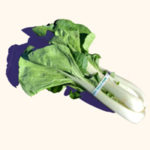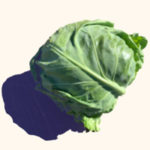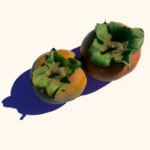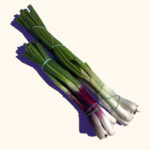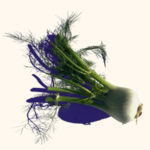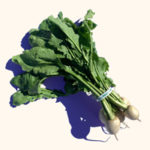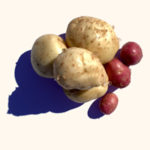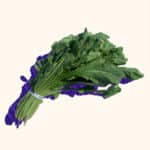What’s in my box this week?
Click on your delivery date to see what is in your box this week. Note that the web site is updated daily to reflect the NEXT day’s deliveries but before that, will show the information from the previous week. You can check an earlier day in the week to get an idea of what will be in your box, but the contents of your box may be different as the box contents frequently change between days.
Tuesday: December 9
- bok choi
- broccoli
- cabbage
- carnival squash
- carrots
- persimmons
- pomegranates
- scunions
*Click on produce above for Recipes
Veggie Tips
Bok Choi – We love bock choi for its crunchy stems and soft leaves, good for cooking or eating raw. Try a salad (we’ve got several ideas on our website), slaw, or pesto. Bok choi makes a great stir-fry and CSA members have recommended grilling their choi (“cut in half, grilled with sesame oil and sprinkled with sesame seeds and salt”). No grill? Use a cast iron. It is also good in soups (try tortilla stew or pasta e fagioli) and with noodles. Other ideas: the Recipe of the Week, miso soup, lentil soup, noodles, sautéed with potatoes, a stir-fry with broccoli (no mushrooms? Make this version), or a chickpea and squash stew. Store in the refrigerator in a bag.
Broccoli – This week, you’re getting a bag of spears! Broccoli can be eaten raw or there are so many ways it can be cooked: roasted (try smashed or adding scunion tops!), steamed (basic instructions here, and you can also make a salad, pasta sauce or soup), blanched, stir-fried, sauteed, broiled, grilled, and more. If you’re looking for a fast meal, how about a one-pot pasta or a stir-fry with bok choi or scunions? This page has a run-through (and raking) of all the broccoli cooking options! CSA members have recommended this pasta recipe and this recipe for leftover broccoli. We’ve got lots of recipe ideas on our website. Store broccoli in the refrigerator in a bag, with additional storage tips here.
Cabbage – Cabbage is one of the most versatile vegetables around – good for cooking, eating raw (several slaw and salad recipes on our website, you can add pomegranate seeds too), or fermenting (it makes excellent sauerkraut). Bonus: it stores well (refrigerated, in a bag) too. CSA members have recommended making roasted cabbage steaks, grilled, or roasted with walnuts. Cabbage makes great soup and goes well with potatoes and squash. We have lots of other ideas on our website’s cabbage page, and there are more on this page.
Carnival Squash – Carnival squash is actually a hybrid of sweet dumpling and acorn squash. Similar to these squashes, it’s got a smooth texture and nutty taste, and the shape is perfect for filling with your stuffing of choice! Carnival squash is at its best when roasted to concentrate and bring out its flavors (add pomegranate seeds or parmesan), but it can also be sautéed or steamed or even eaten raw, . You don’t need to remove the skin (it’s a matter of personal preference) and the seeds can be roasted and eaten too. If you’ve still got leeks from last week, consider roasting them with your squash! Check out the many ideas on our website; it could easily swap in for acorn, sweet dumpling, or delicata.
Carrots – We grow super sweet Nantes carrots. More information about our carrots and how we grow and harvest them here. Separate the root from the greens before storing them in the refrigerator, both in bags. We encourage you to give the carrot tops a try. You can add the greens to any soup or salad. Or make broth, pesto, chimichurri, a warm salad, couscous, salsa verde (add to potatoes), or oil (add to roasted squash squash). More ideas here and here. For the roots: see the many recipes on our website.
Persimmons – These are Fuyu persimmons. They’re the non-astringent type, meaning they can be eaten firm. They don’t need to get squishy. Over a week or so, they will soften, whether left on the counter or kept in the fridge. Sometimes the skin has black marks; these are purely cosmetic! Another option is to add to a salad: including with bok choi, broccoli, or carrots. You can also make pickled persimmons.
Pomegranates – Pomegranates – Methods abound for how to remove the seeds but the most common are submerging underwater, peeling in segments, whacking with a spoon (recommended by chef Samin Nosrat too). Regardless of how you do it, it’s always worth it once you’ve got bowl of beautiful, sweet/tart arils (the seeds) to use in sweet or savory dishes, or eat plain. For best storage, put pomegranates in the refrigerator where they can last up to two months. However, you can leave them out at room temperature where they’ll be fine for a few weeks, though the outside will dry out. Seeds last up to a week in the refrigerator, and you can also juice your pomegranates and freeze the juice. You can add pomegranate seeds to anything – CSA members have reported that they enjoy them with oatmeal, with yogurt, toast with nut butter, and by the handful! A few more recipe ideas and tips on our website.
Scunions – A scunion is a combination of “scallion” and “onion.” It can be used just like a spring onion or scallion (more about the differences here) when cooking but it’s grown differently. Most of the spring onions we grow are immature onions. Scunions are the sprouts that you get from planting onions that are past their prime, just like how we plant “old” garlic and potatoes to get a new crop. Some cooking ideas: the Recipe of the Week, scallion pancakes, with broccoli, charred (with salad or pasta), tabbouleh, soup, a broccoli stir-fry, on braised cabbage, or any of the dishes on this list.
Wednesday: December 10
- bok choi
- broccoli
- cabbage
- carnival squash
- carrots
- persimmons
- pomegranates
- scunions
*Click on produce above for Recipes
Veggie Tips
Bok Choi – We love bock choi for its crunchy stems and soft leaves, good for cooking or eating raw. Try a salad (we’ve got several ideas on our website), slaw, or pesto. Bok choi makes a great stir-fry and CSA members have recommended grilling their choi (“cut in half, grilled with sesame oil and sprinkled with sesame seeds and salt”). No grill? Use a cast iron. It is also good in soups (try tortilla stew or pasta e fagioli) and with noodles. Other ideas: the Recipe of the Week, miso soup, lentil soup, noodles, sautéed with potatoes, a stir-fry with broccoli (no mushrooms? Make this version), or a chickpea and squash stew. Store in the refrigerator in a bag.
Broccoli – This week, you’re getting a bag of spears! Broccoli can be eaten raw or there are so many ways it can be cooked: roasted (try smashed or adding scunion tops!), steamed (basic instructions here, and you can also make a salad, pasta sauce or soup), blanched, stir-fried, sauteed, broiled, grilled, and more. If you’re looking for a fast meal, how about a one-pot pasta or a stir-fry with bok choi or scunions? This page has a run-through (and raking) of all the broccoli cooking options! CSA members have recommended this pasta recipe and this recipe for leftover broccoli. We’ve got lots of recipe ideas on our website. Store broccoli in the refrigerator in a bag, with additional storage tips here.
Cabbage – Cabbage is one of the most versatile vegetables around – good for cooking, eating raw (several slaw and salad recipes on our website, you can add pomegranate seeds too), or fermenting (it makes excellent sauerkraut). Bonus: it stores well (refrigerated, in a bag) too. CSA members have recommended making roasted cabbage steaks, grilled, or roasted with walnuts. Cabbage makes great soup and goes well with potatoes and squash. We have lots of other ideas on our website’s cabbage page, and there are more on this page.
Carnival Squash – Carnival squash is actually a hybrid of sweet dumpling and acorn squash. Similar to these squashes, it’s got a smooth texture and nutty taste, and the shape is perfect for filling with your stuffing of choice! Carnival squash is at its best when roasted to concentrate and bring out its flavors (add pomegranate seeds or parmesan), but it can also be sautéed or steamed or even eaten raw, . You don’t need to remove the skin (it’s a matter of personal preference) and the seeds can be roasted and eaten too. If you’ve still got leeks from last week, consider roasting them with your squash! Check out the many ideas on our website; it could easily swap in for acorn, sweet dumpling, or delicata.
Carrots – We grow super sweet Nantes carrots. More information about our carrots and how we grow and harvest them here. Separate the root from the greens before storing them in the refrigerator, both in bags. We encourage you to give the carrot tops a try. You can add the greens to any soup or salad. Or make broth, pesto, chimichurri, a warm salad, couscous, salsa verde (add to potatoes), or oil (add to roasted squash squash). More ideas here and here. For the roots: see the many recipes on our website.
Persimmons – These are Fuyu persimmons. They’re the non-astringent type, meaning they can be eaten firm. They don’t need to get squishy. Over a week or so, they will soften, whether left on the counter or kept in the fridge. Sometimes the skin has black marks; these are purely cosmetic! Another option is to add to a salad: including with bok choi, broccoli, or carrots. You can also make pickled persimmons.
Pomegranates – Pomegranates – Methods abound for how to remove the seeds but the most common are submerging underwater, peeling in segments, whacking with a spoon (recommended by chef Samin Nosrat too). Regardless of how you do it, it’s always worth it once you’ve got bowl of beautiful, sweet/tart arils (the seeds) to use in sweet or savory dishes, or eat plain. For best storage, put pomegranates in the refrigerator where they can last up to two months. However, you can leave them out at room temperature where they’ll be fine for a few weeks, though the outside will dry out. Seeds last up to a week in the refrigerator, and you can also juice your pomegranates and freeze the juice. You can add pomegranate seeds to anything – CSA members have reported that they enjoy them with oatmeal, with yogurt, toast with nut butter, and by the handful! A few more recipe ideas and tips on our website.
Scunions – A scunion is a combination of “scallion” and “onion.” It can be used just like a spring onion or scallion (more about the differences here) when cooking but it’s grown differently. Most of the spring onions we grow are immature onions. Scunions are the sprouts that you get from planting onions that are past their prime, just like how we plant “old” garlic and potatoes to get a new crop. Some cooking ideas: the Recipe of the Week, scallion pancakes, with broccoli, charred (with salad or pasta), tabbouleh, soup, a broccoli stir-fry, on braised cabbage, or any of the dishes on this list.
Thursday: December 11
- bok choi
- broccoli
- cabbage
- carnival squash
- carrots
- persimmons
- pomegranates
- scunions
*Click on produce above for Recipes
Veggie Tips
Bok Choi – We love bock choi for its crunchy stems and soft leaves, good for cooking or eating raw. Try a salad (we’ve got several ideas on our website), slaw, or pesto. Bok choi makes a great stir-fry and CSA members have recommended grilling their choi (“cut in half, grilled with sesame oil and sprinkled with sesame seeds and salt”). No grill? Use a cast iron. It is also good in soups (try tortilla stew or pasta e fagioli) and with noodles. Other ideas: the Recipe of the Week, miso soup, lentil soup, noodles, sautéed with potatoes, a stir-fry with broccoli (no mushrooms? Make this version), or a chickpea and squash stew. Store in the refrigerator in a bag.
Broccoli – This week, you’re getting a bag of spears! Broccoli can be eaten raw or there are so many ways it can be cooked: roasted (try smashed or adding scunion tops!), steamed (basic instructions here, and you can also make a salad, pasta sauce or soup), blanched, stir-fried, sauteed, broiled, grilled, and more. If you’re looking for a fast meal, how about a one-pot pasta or a stir-fry with bok choi or scunions? This page has a run-through (and raking) of all the broccoli cooking options! CSA members have recommended this pasta recipe and this recipe for leftover broccoli. We’ve got lots of recipe ideas on our website. Store broccoli in the refrigerator in a bag, with additional storage tips here.
Cabbage – Cabbage is one of the most versatile vegetables around – good for cooking, eating raw (several slaw and salad recipes on our website, you can add pomegranate seeds too), or fermenting (it makes excellent sauerkraut). Bonus: it stores well (refrigerated, in a bag) too. CSA members have recommended making roasted cabbage steaks, grilled, or roasted with walnuts. Cabbage makes great soup and goes well with potatoes and squash. We have lots of other ideas on our website’s cabbage page, and there are more on this page.
Carnival Squash – Carnival squash is actually a hybrid of sweet dumpling and acorn squash. Similar to these squashes, it’s got a smooth texture and nutty taste, and the shape is perfect for filling with your stuffing of choice! Carnival squash is at its best when roasted to concentrate and bring out its flavors (add pomegranate seeds or parmesan), but it can also be sautéed or steamed or even eaten raw, . You don’t need to remove the skin (it’s a matter of personal preference) and the seeds can be roasted and eaten too. If you’ve still got leeks from last week, consider roasting them with your squash! Check out the many ideas on our website; it could easily swap in for acorn, sweet dumpling, or delicata.
Carrots – We grow super sweet Nantes carrots. More information about our carrots and how we grow and harvest them here. Separate the root from the greens before storing them in the refrigerator, both in bags. We encourage you to give the carrot tops a try. You can add the greens to any soup or salad. Or make broth, pesto, chimichurri, a warm salad, couscous, salsa verde (add to potatoes), or oil (add to roasted squash squash). More ideas here and here. For the roots: see the many recipes on our website.
Persimmons – These are Fuyu persimmons. They’re the non-astringent type, meaning they can be eaten firm. They don’t need to get squishy. Over a week or so, they will soften, whether left on the counter or kept in the fridge. Sometimes the skin has black marks; these are purely cosmetic! Another option is to add to a salad: including with bok choi, broccoli, or carrots. You can also make pickled persimmons.
Pomegranates – Pomegranates – Methods abound for how to remove the seeds but the most common are submerging underwater, peeling in segments, whacking with a spoon (recommended by chef Samin Nosrat too). Regardless of how you do it, it’s always worth it once you’ve got bowl of beautiful, sweet/tart arils (the seeds) to use in sweet or savory dishes, or eat plain. For best storage, put pomegranates in the refrigerator where they can last up to two months. However, you can leave them out at room temperature where they’ll be fine for a few weeks, though the outside will dry out. Seeds last up to a week in the refrigerator, and you can also juice your pomegranates and freeze the juice. You can add pomegranate seeds to anything – CSA members have reported that they enjoy them with oatmeal, with yogurt, toast with nut butter, and by the handful! A few more recipe ideas and tips on our website.
Scunions – A scunion is a combination of “scallion” and “onion.” It can be used just like a spring onion or scallion (more about the differences here) when cooking but it’s grown differently. Most of the spring onions we grow are immature onions. Scunions are the sprouts that you get from planting onions that are past their prime, just like how we plant “old” garlic and potatoes to get a new crop. Some cooking ideas: the Recipe of the Week, scallion pancakes, with broccoli, charred (with salad or pasta), tabbouleh, soup, a broccoli stir-fry, on braised cabbage, or any of the dishes on this list.
Friday: December 12
- bok choi
- broccoli
- cabbage
- carnival squash
- carrots
- persimmons
- pomegranates
- scunions
*Click on produce above for Recipes
Veggie Tips
Bok Choi – We love bock choi for its crunchy stems and soft leaves, good for cooking or eating raw. Try a salad (we’ve got several ideas on our website), slaw, or pesto. Bok choi makes a great stir-fry and CSA members have recommended grilling their choi (“cut in half, grilled with sesame oil and sprinkled with sesame seeds and salt”). No grill? Use a cast iron. It is also good in soups (try tortilla stew or pasta e fagioli) and with noodles. Other ideas: the Recipe of the Week, miso soup, lentil soup, noodles, sautéed with potatoes, a stir-fry with broccoli (no mushrooms? Make this version), or a chickpea and squash stew. Store in the refrigerator in a bag.
Broccoli – This week, you’re getting a bag of spears! Broccoli can be eaten raw or there are so many ways it can be cooked: roasted (try smashed or adding scunion tops!), steamed (basic instructions here, and you can also make a salad, pasta sauce or soup), blanched, stir-fried, sauteed, broiled, grilled, and more. If you’re looking for a fast meal, how about a one-pot pasta or a stir-fry with bok choi or scunions? This page has a run-through (and raking) of all the broccoli cooking options! CSA members have recommended this pasta recipe and this recipe for leftover broccoli. We’ve got lots of recipe ideas on our website. Store broccoli in the refrigerator in a bag, with additional storage tips here.
Cabbage – Cabbage is one of the most versatile vegetables around – good for cooking, eating raw (several slaw and salad recipes on our website, you can add pomegranate seeds too), or fermenting (it makes excellent sauerkraut). Bonus: it stores well (refrigerated, in a bag) too. CSA members have recommended making roasted cabbage steaks, grilled, or roasted with walnuts. Cabbage makes great soup and goes well with potatoes and squash. We have lots of other ideas on our website’s cabbage page, and there are more on this page.
Carnival Squash – Carnival squash is actually a hybrid of sweet dumpling and acorn squash. Similar to these squashes, it’s got a smooth texture and nutty taste, and the shape is perfect for filling with your stuffing of choice! Carnival squash is at its best when roasted to concentrate and bring out its flavors (add pomegranate seeds or parmesan), but it can also be sautéed or steamed or even eaten raw, . You don’t need to remove the skin (it’s a matter of personal preference) and the seeds can be roasted and eaten too. If you’ve still got leeks from last week, consider roasting them with your squash! Check out the many ideas on our website; it could easily swap in for acorn, sweet dumpling, or delicata.
Carrots – We grow super sweet Nantes carrots. More information about our carrots and how we grow and harvest them here. We aim to harvest the carrots with the greens, but sometimes the greens snap off! This week you’re getting bagged carrots without the greens, but otherwise, they’re the same carrots (and you’re getting more than you would in a bunch!). For longer term storage, we recommend a plastic bag instead of the wax bags that they come in. If your carrots do get a little limp, you can revive them by putting them in water, even for just five minutes. We have many recipes on the web and they taste great raw as a snack.
Persimmons – These are Fuyu persimmons. They’re the non-astringent type, meaning they can be eaten firm. They don’t need to get squishy. Over a week or so, they will soften, whether left on the counter or kept in the fridge. Sometimes the skin has black marks; these are purely cosmetic! Another option is to add to a salad: including with bok choi, broccoli, or carrots. You can also make pickled persimmons.
Pomegranates – Pomegranates – Methods abound for how to remove the seeds but the most common are submerging underwater, peeling in segments, whacking with a spoon (recommended by chef Samin Nosrat too). Regardless of how you do it, it’s always worth it once you’ve got bowl of beautiful, sweet/tart arils (the seeds) to use in sweet or savory dishes, or eat plain. For best storage, put pomegranates in the refrigerator where they can last up to two months. However, you can leave them out at room temperature where they’ll be fine for a few weeks, though the outside will dry out. Seeds last up to a week in the refrigerator, and you can also juice your pomegranates and freeze the juice. You can add pomegranate seeds to anything – CSA members have reported that they enjoy them with oatmeal, with yogurt, toast with nut butter, and by the handful! A few more recipe ideas and tips on our website.
Scunions – A scunion is a combination of “scallion” and “onion.” It can be used just like a spring onion or scallion (more about the differences here) when cooking but it’s grown differently. Most of the spring onions we grow are immature onions. Scunions are the sprouts that you get from planting onions that are past their prime, just like how we plant “old” garlic and potatoes to get a new crop. Some cooking ideas: the Recipe of the Week, scallion pancakes, with broccoli, charred (with salad or pasta), tabbouleh, soup, a broccoli stir-fry, on braised cabbage, or any of the dishes on this list.
Saturday: December 13
- bok choi
- broccoli
- cabbage
- carnival squash
- carrots
- persimmons
- pomegranates
- scunions
*Click on produce above for Recipes
Veggie Tips
Bok Choi – We love bock choi for its crunchy stems and soft leaves, good for cooking or eating raw. Try a salad (we’ve got several ideas on our website), slaw, or pesto. Bok choi makes a great stir-fry and CSA members have recommended grilling their choi (“cut in half, grilled with sesame oil and sprinkled with sesame seeds and salt”). No grill? Use a cast iron. It is also good in soups (try tortilla stew or pasta e fagioli) and with noodles. Other ideas: the Recipe of the Week, miso soup, lentil soup, noodles, sautéed with potatoes, a stir-fry with broccoli (no mushrooms? Make this version), or a chickpea and squash stew. Store in the refrigerator in a bag.
Broccoli – This week, you’re getting a bag of spears! Broccoli can be eaten raw or there are so many ways it can be cooked: roasted (try smashed or adding scunion tops!), steamed (basic instructions here, and you can also make a salad, pasta sauce or soup), blanched, stir-fried, sauteed, broiled, grilled, and more. If you’re looking for a fast meal, how about a one-pot pasta or a stir-fry with bok choi or scunions? This page has a run-through (and raking) of all the broccoli cooking options! CSA members have recommended this pasta recipe and this recipe for leftover broccoli. We’ve got lots of recipe ideas on our website. Store broccoli in the refrigerator in a bag, with additional storage tips here.
Cabbage – Cabbage is one of the most versatile vegetables around – good for cooking, eating raw (several slaw and salad recipes on our website, you can add pomegranate seeds too), or fermenting (it makes excellent sauerkraut). Bonus: it stores well (refrigerated, in a bag) too. CSA members have recommended making roasted cabbage steaks, grilled, or roasted with walnuts. Cabbage makes great soup and goes well with potatoes and squash. We have lots of other ideas on our website’s cabbage page, and there are more on this page.
Carnival Squash – Carnival squash is actually a hybrid of sweet dumpling and acorn squash. Similar to these squashes, it’s got a smooth texture and nutty taste, and the shape is perfect for filling with your stuffing of choice! Carnival squash is at its best when roasted to concentrate and bring out its flavors (add pomegranate seeds or parmesan), but it can also be sautéed or steamed or even eaten raw, . You don’t need to remove the skin (it’s a matter of personal preference) and the seeds can be roasted and eaten too. If you’ve still got leeks from last week, consider roasting them with your squash! Check out the many ideas on our website; it could easily swap in for acorn, sweet dumpling, or delicata.
Carrots – We grow super sweet Nantes carrots. More information about our carrots and how we grow and harvest them here. We aim to harvest the carrots with the greens, but sometimes the greens snap off! This week you’re getting bagged carrots without the greens, but otherwise, they’re the same carrots (and you’re getting more than you would in a bunch!). For longer term storage, we recommend a plastic bag instead of the wax bags that they come in. If your carrots do get a little limp, you can revive them by putting them in water, even for just five minutes. We have many recipes on the web and they taste great raw as a snack.
Persimmons – These are Fuyu persimmons. They’re the non-astringent type, meaning they can be eaten firm. They don’t need to get squishy. Over a week or so, they will soften, whether left on the counter or kept in the fridge. Sometimes the skin has black marks; these are purely cosmetic! Another option is to add to a salad: including with bok choi, broccoli, or carrots. You can also make pickled persimmons.
Pomegranates – Pomegranates – Methods abound for how to remove the seeds but the most common are submerging underwater, peeling in segments, whacking with a spoon (recommended by chef Samin Nosrat too). Regardless of how you do it, it’s always worth it once you’ve got bowl of beautiful, sweet/tart arils (the seeds) to use in sweet or savory dishes, or eat plain. For best storage, put pomegranates in the refrigerator where they can last up to two months. However, you can leave them out at room temperature where they’ll be fine for a few weeks, though the outside will dry out. Seeds last up to a week in the refrigerator, and you can also juice your pomegranates and freeze the juice. You can add pomegranate seeds to anything – CSA members have reported that they enjoy them with oatmeal, with yogurt, toast with nut butter, and by the handful! A few more recipe ideas and tips on our website.
Scunions – A scunion is a combination of “scallion” and “onion.” It can be used just like a spring onion or scallion (more about the differences here) when cooking but it’s grown differently. Most of the spring onions we grow are immature onions. Scunions are the sprouts that you get from planting onions that are past their prime, just like how we plant “old” garlic and potatoes to get a new crop. Some cooking ideas: the Recipe of the Week, scallion pancakes, with broccoli, charred (with salad or pasta), tabbouleh, soup, a broccoli stir-fry, on braised cabbage, or any of the dishes on this list.
Tuesday: December 2
- fennel
- frisée
- hakurei turnips
- kabocha squash
- karinata kale
- persimmons
- potatoes
*Click on produce above for Recipes
Veggie Tips
Fennel – For easier storage, separate the fronds from the bulb. For the fronds: many people like making a fennel frond pesto (add to risotto), or using it like an herb when cooking. Or save the stalks and fronds for stock/broth. The bulb is popular thinly shaved and added to a salad, especially with citrus, olives, both, cheese, or carrots. It can be made into a Caesar salad or massaged. You can also make a quick pickle and CSA members have shared that they use fennel stems as a substitute for celery in potato salad and soup. If you don’t like the taste of it raw, try cooking: roasting, braising, sautéing (see the Recipe of the Week!), or grilling will transform the taste – cooked fennel tastes like a combination between onion and celery. It makes a great base for soup or stew, especially with kabocha like this soup or this one! We also like it braised or caramelized (we have several recipes on the website) and it’s a good addition to other roasted or sautéed vegetables. Check out the other recipes on our website.
Frisée – This week you’re getting a gorgeous head of frisée! Also called “curly endive,” it’s got frilly leaves, and a slightly bitter flavor that pairs well with strong, bold flavors (cheese, vinaigrettes, dried fruit, cured meats, eggs, etc.). Add roasted potatoes! It’s most commonly used in salad mixes – see here for some salad ideas. It can also be wilted, sautéed, or stir-fried to mellow its bitterness, or added to soups. You can use it like escarole, another member of the endive/chicory family which is often used in bean soups. A CSA member recommended grilling it (cut into quarters, put a little olive oil and salt, grilled a few minutes on each side, then served with a vinaigrette). Store in a bag in the refrigerator.
Hakurei Turnips – These farm favorites go by several names: salad turnips, Tokyo turnips, and Japanese turnips. They’re called salad turnips because they have a sweet flavor and taste good raw. They have thin, tender skins; you don’t need to peel. They can also be cooked (roasted, sautéed, boiled, grilled, steamed, mashed). You can use them anywhere you’d use radishes, though they don’t have any of the heat of a radish. They make good pickles – try with ginger or garlic, or see more suggestions in the persimmon section below. This website has a few more general pointers and this recipe has several Japanese style recipes. Don’t discard the greens; they are tender and soft, with a mild taste. Direct quote from one of our owners, Andrew: “they’re the best part! And really good for you.” You can cook the greens with the turnips, see the Recipe of the Week, or use them raw anywhere you’d use arugula or spinach. Pesto too. To store: remove the greens and store the greens and roots in separate plastic bags in the fridge. The greens will last up to a week, but the roots have a much longer shelf-life. Check out the recipes on our website including a delicious miso turnip recipe; a CSA member says that she always makes it when she gets turnips in her box. A few other ideas: roasted with apples, caramelized with fennel, pan-fried with feta and pistachios, or curry noodle soup.
Kabocha Squash – We love kabocha squash for its rich, sweet taste, almost like a sweet potato. It is excellent roasted, and can also be simmered, cooked in soups (with fennel too, like this one) and curries, steamed, stir-fried, pan-fried, grilled, braised, and more. It can even be made into chips or hummus! You can swap kabocha for pumpkin (or kuri) in any recipe and it makes excellent desserts. We have additional recipe ideas on our website, and this list has a few more. The skin is edible and does not need to be removed. The squash in your box this week may have some bumps on the outside. These are purely cosmetic and don’t impact the taste or quality of the squash, though perhaps skip eating those. Kabocha can be stored in a cool, dry place, and they will last quite a while, up to 4 months, but make sure to check for scratches or nicks in the skin because those won’t last as long!
Karinata Kale – This beautiful purple kale is a cross between mustard greens and kale with a unique taste. We’re one of only three farms (that we know of) that grow it! Use as you would any kale or mustard green (like in this salad with kabocha squash), but beware that it may stain your food purple! We’ve got many kale recipe ideas on our website. Store in the refrigerator in a bag to keep from wilting.
Persimmons – These are Fuyu persimmons. They’re the non-astringent type, not the type that needs to be squishy before eating. They are most often eaten firm. Over a week or so, they will soften, whether left on the counter or kept in the fridge. Sometimes the skin has black marks; these are purely cosmetic! Another option is to add to a salad: kale, frisée, kabocha and kale, fennel (use turnip greens instead of arugula), fennel and frisée, or turnips. You can also make pickled persimmons – plain or Japanese pickles with turnip (a few ideas – here and here).
Potatoes – We’re currently harvesting Bintje (white), Yukon gold (yellow), bella roja (red). These are straight from the field and the skins are still very soft and may get scuffed in the harvesting process, but that won’t impact the taste. You MUST store them in the refrigerator out of the light to avoid them turning green. We’ve got lots of recipe ideas on our website.
Wednesday: December 3
- fennel
- frisée
- hakurei turnips
- kabocha squash
- karinata kale
- persimmons
- potatoes
*Click on produce above for Recipes
Veggie Tips
Fennel – For easier storage, separate the fronds from the bulb. For the fronds: many people like making a fennel frond pesto (add to risotto), or using it like an herb when cooking. Or save the stalks and fronds for stock/broth. The bulb is popular thinly shaved and added to a salad, especially with citrus, olives, both, cheese, or carrots. It can be made into a Caesar salad or massaged. You can also make a quick pickle and CSA members have shared that they use fennel stems as a substitute for celery in potato salad and soup. If you don’t like the taste of it raw, try cooking: roasting, braising, sautéing (see the Recipe of the Week!), or grilling will transform the taste – cooked fennel tastes like a combination between onion and celery. It makes a great base for soup or stew, especially with kabocha like this soup or this one! We also like it braised or caramelized (we have several recipes on the website) and it’s a good addition to other roasted or sautéed vegetables. Check out the other recipes on our website.
Frisée – This week you’re getting a gorgeous head of frisée! Also called “curly endive,” it’s got frilly leaves, and a slightly bitter flavor that pairs well with strong, bold flavors (cheese, vinaigrettes, dried fruit, cured meats, eggs, etc.). Add roasted potatoes! It’s most commonly used in salad mixes – see here for some salad ideas. It can also be wilted, sautéed, or stir-fried to mellow its bitterness, or added to soups. You can use it like escarole, another member of the endive/chicory family which is often used in bean soups. A CSA member recommended grilling it (cut into quarters, put a little olive oil and salt, grilled a few minutes on each side, then served with a vinaigrette). Store in a bag in the refrigerator.
Hakurei Turnips – These farm favorites go by several names: salad turnips, Tokyo turnips, and Japanese turnips. They’re called salad turnips because they have a sweet flavor and taste good raw. They have thin, tender skins; you don’t need to peel. They can also be cooked (roasted, sautéed, boiled, grilled, steamed, mashed). You can use them anywhere you’d use radishes, though they don’t have any of the heat of a radish. They make good pickles – try with ginger or garlic, or see more suggestions in the persimmon section below. This website has a few more general pointers and this recipe has several Japanese style recipes. Don’t discard the greens; they are tender and soft, with a mild taste. Direct quote from one of our owners, Andrew: “they’re the best part! And really good for you.” You can cook the greens with the turnips, see the Recipe of the Week, or use them raw anywhere you’d use arugula or spinach. Pesto too. To store: remove the greens and store the greens and roots in separate plastic bags in the fridge. The greens will last up to a week, but the roots have a much longer shelf-life. Check out the recipes on our website including a delicious miso turnip recipe; a CSA member says that she always makes it when she gets turnips in her box. A few other ideas: roasted with apples, caramelized with fennel, pan-fried with feta and pistachios, or curry noodle soup.
Kabocha Squash – We love kabocha squash for its rich, sweet taste, almost like a sweet potato. It is excellent roasted, and can also be simmered, cooked in soups (with fennel too, like this one) and curries, steamed, stir-fried, pan-fried, grilled, braised, and more. It can even be made into chips or hummus! You can swap kabocha for pumpkin (or kuri) in any recipe and it makes excellent desserts. We have additional recipe ideas on our website, and this list has a few more. The skin is edible and does not need to be removed. The squash in your box this week may have some bumps on the outside. These are purely cosmetic and don’t impact the taste or quality of the squash, though perhaps skip eating those. Kabocha can be stored in a cool, dry place, and they will last quite a while, up to 4 months, but make sure to check for scratches or nicks in the skin because those won’t last as long!
Karinata Kale – This beautiful purple kale is a cross between mustard greens and kale with a unique taste. We’re one of only three farms (that we know of) that grow it! Use as you would any kale or mustard green (like in this salad with kabocha squash), but beware that it may stain your food purple! We’ve got many kale recipe ideas on our website. Store in the refrigerator in a bag to keep from wilting.
Persimmons – These are Fuyu persimmons. They’re the non-astringent type, not the type that needs to be squishy before eating. They are most often eaten firm. Over a week or so, they will soften, whether left on the counter or kept in the fridge. Sometimes the skin has black marks; these are purely cosmetic! Another option is to add to a salad: kale, frisée, kabocha and kale, fennel (use turnip greens instead of arugula), fennel and frisée, or turnips. You can also make pickled persimmons – plain or Japanese pickles with turnip (a few ideas – here and here).
Potatoes – We’re currently harvesting Bintje (white), Yukon gold (yellow), bella roja (red). These are straight from the field and the skins are still very soft and may get scuffed in the harvesting process, but that won’t impact the taste. You MUST store them in the refrigerator out of the light to avoid them turning green. We’ve got lots of recipe ideas on our website.
Thursday: December 4
- fennel
- frisée
- hakurei turnips
- kabocha squash
- karinata kale
- persimmons
- potatoes
*Click on produce above for Recipes
Veggie Tips
Fennel – For easier storage, separate the fronds from the bulb. For the fronds: many people like making a fennel frond pesto (add to risotto), or using it like an herb when cooking. Or save the stalks and fronds for stock/broth. The bulb is popular thinly shaved and added to a salad, especially with citrus, olives, both, cheese, or carrots. It can be made into a Caesar salad or massaged. You can also make a quick pickle and CSA members have shared that they use fennel stems as a substitute for celery in potato salad and soup. If you don’t like the taste of it raw, try cooking: roasting, braising, sautéing (see the Recipe of the Week!), or grilling will transform the taste – cooked fennel tastes like a combination between onion and celery. It makes a great base for soup or stew, especially with kabocha like this soup or this one! We also like it braised or caramelized (we have several recipes on the website) and it’s a good addition to other roasted or sautéed vegetables. Check out the other recipes on our website.
Frisée – This week you’re getting a gorgeous head of frisée! Also called “curly endive,” it’s got frilly leaves, and a slightly bitter flavor that pairs well with strong, bold flavors (cheese, vinaigrettes, dried fruit, cured meats, eggs, etc.). Add roasted potatoes! It’s most commonly used in salad mixes – see here for some salad ideas. It can also be wilted, sautéed, or stir-fried to mellow its bitterness, or added to soups. You can use it like escarole, another member of the endive/chicory family which is often used in bean soups. A CSA member recommended grilling it (cut into quarters, put a little olive oil and salt, grilled a few minutes on each side, then served with a vinaigrette). Store in a bag in the refrigerator.
Hakurei Turnips – These farm favorites go by several names: salad turnips, Tokyo turnips, and Japanese turnips. They’re called salad turnips because they have a sweet flavor and taste good raw. They have thin, tender skins; you don’t need to peel. They can also be cooked (roasted, sautéed, boiled, grilled, steamed, mashed). You can use them anywhere you’d use radishes, though they don’t have any of the heat of a radish. They make good pickles – try with ginger or garlic, or see more suggestions in the persimmon section below. This website has a few more general pointers and this recipe has several Japanese style recipes. Don’t discard the greens; they are tender and soft, with a mild taste. Direct quote from one of our owners, Andrew: “they’re the best part! And really good for you.” You can cook the greens with the turnips, see the Recipe of the Week, or use them raw anywhere you’d use arugula or spinach. Pesto too. To store: remove the greens and store the greens and roots in separate plastic bags in the fridge. The greens will last up to a week, but the roots have a much longer shelf-life. Check out the recipes on our website including a delicious miso turnip recipe; a CSA member says that she always makes it when she gets turnips in her box. A few other ideas: roasted with apples, caramelized with fennel, pan-fried with feta and pistachios, or curry noodle soup.
Kabocha Squash – We love kabocha squash for its rich, sweet taste, almost like a sweet potato. It is excellent roasted, and can also be simmered, cooked in soups (with fennel too, like this one) and curries, steamed, stir-fried, pan-fried, grilled, braised, and more. It can even be made into chips or hummus! You can swap kabocha for pumpkin (or kuri) in any recipe and it makes excellent desserts. We have additional recipe ideas on our website, and this list has a few more. The skin is edible and does not need to be removed. The squash in your box this week may have some bumps on the outside. These are purely cosmetic and don’t impact the taste or quality of the squash, though perhaps skip eating those. Kabocha can be stored in a cool, dry place, and they will last quite a while, up to 4 months, but make sure to check for scratches or nicks in the skin because those won’t last as long!
Karinata Kale – This beautiful purple kale is a cross between mustard greens and kale with a unique taste. We’re one of only three farms (that we know of) that grow it! Use as you would any kale or mustard green (like in this salad with kabocha squash), but beware that it may stain your food purple! We’ve got many kale recipe ideas on our website. Store in the refrigerator in a bag to keep from wilting.
Persimmons – These are Fuyu persimmons. They’re the non-astringent type, not the type that needs to be squishy before eating. They are most often eaten firm. Over a week or so, they will soften, whether left on the counter or kept in the fridge. Sometimes the skin has black marks; these are purely cosmetic! Another option is to add to a salad: kale, frisée, kabocha and kale, fennel (use turnip greens instead of arugula), fennel and frisée, or turnips. You can also make pickled persimmons – plain or Japanese pickles with turnip (a few ideas – here and here).
Potatoes – We’re currently harvesting Bintje (white), Yukon gold (yellow), bella roja (red). These are straight from the field and the skins are still very soft and may get scuffed in the harvesting process, but that won’t impact the taste. You MUST store them in the refrigerator out of the light to avoid them turning green. We’ve got lots of recipe ideas on our website.
Friday: December 5
- carrots
- fennel
- frisée
- kabocha squash
- karinata kale
- persimmons
- potatoes
*Click on produce above for Recipes
Veggie Tips
Carrots – We grow super sweet Nantes carrots. More information about our carrots and how we grow and harvest them here. Separate the root from the greens before storing them in the refrigerator, both in bags. We encourage you to give the carrot tops a try. You can add the greens to any soup or salad. Or make broth, pesto (add fennel fronds too), chimichurri, a warm salad, couscous, salsa verde (add to potatoes), or oil (add to kabocha squash). More ideas here and here. For the roots: see the Recipe of the Week, and we have many recipes on the web and they taste great raw as a snack.
Fennel – For easier storage, separate the fronds from the bulb. For the fronds: many people like making a fennel frond pesto (add to risotto, plus you can also add carrot greens), or using it like an herb when cooking. Or save the stalks and fronds for stock/broth. The bulb is popular thinly shaved and added to a salad, especially with citrus, olives, both, cheese, or carrots, (see the Recipe of the Week). It can be made into a Caesar salad or massaged. You can also make a quick pickle and CSA members have shared that they use fennel stems as a substitute for celery in potato salad and soup. If you don’t like the taste of it raw, try cooking: roasting, braising, sautéing, or grilling will transform the taste – cooked fennel tastes like a combination between onion and celery. It makes a great base for soup or stew, especially with kabocha like this soup or this one! We also like it braised or caramelized (we have several recipes on the website) and it’s a good addition to other roasted or sautéed vegetables, like carrots. Check out the other recipes on our website.
Frisée – This week you’re getting a gorgeous head of frisée! Also called “curly endive,” it’s got frilly leaves, and a slightly bitter flavor that pairs well with strong, bold flavors (cheese, vinaigrettes, dried fruit, cured meats, eggs, etc.). Add roasted potatoes or shaved carrots! It’s most commonly used in salad mixes – see here for some salad ideas. It can also be wilted, sautéed, or stir-fried to mellow its bitterness, or added to soups. You can use it like escarole, another member of the endive/chicory family which is often used in bean soups. A CSA member recommended grilling it (cut into quarters, put a little olive oil and salt, grilled a few minutes on each side, then served with a vinaigrette). Store in a bag in the refrigerator.
Kabocha Squash – We love kabocha squash for its rich, sweet taste, almost like a sweet potato. It is excellent roasted, and can also be simmered, cooked in soups (with fennel too, like this one) and curries, steamed, stir-fried, pan-fried, grilled, braised, and more. It can even be made into chips or hummus! You can swap kabocha for pumpkin (or kuri) in any recipe and it makes excellent desserts. We have additional recipe ideas on our website, and this list has a few more. The skin is edible and does not need to be removed. The squash in your box this week may have some bumps on the outside. These are purely cosmetic and don’t impact the taste or quality of the squash, though perhaps skip eating those. Kabocha can be stored in a cool, dry place, and they will last quite a while, up to 4 months, but make sure to check for scratches or nicks in the skin because those won’t last as long!
Karinata Kale – This beautiful purple kale is a cross between mustard greens and kale with a unique taste. We’re one of only three farms (that we know of) that grow it! Use as you would any kale or mustard green (like in this salad with kabocha squash), but beware that it may stain your food purple! We’ve got many kale recipe ideas on our website. Store in the refrigerator in a bag to keep from wilting.
Persimmons – These are Fuyu persimmons. They’re the non-astringent type, not the type that needs to be squishy before eating. They are most often eaten firm. Over a week or so, they will soften, whether left on the counter or kept in the fridge. Sometimes the skin has black marks; these are purely cosmetic! Another option is to add to a salad: kale, frisée, kabocha and kale, carrots, fennel, or fennel and frisée. You can also make pickled persimmons.
Potatoes – We’re currently harvesting Bintje (white), Yukon gold (yellow), bella roja (red). These are straight from the field and the skins are still very soft and may get scuffed in the harvesting process, but that won’t impact the taste. You MUST store them in the refrigerator out of the light to avoid them turning green. We’ve got lots of recipe ideas on our website.
Saturday: December 6
- arugula
- bok choi
- carrots
- kabocha squash
- karinata kale
- persimmons
- potatoes
*Click on produce above for Recipes
Veggie Tips
Arugula – Arugula can be slightly peppery; if you want to tame the spice, lightly cook it. Note that it cooks fast and shrinks quite a bit. It is excellent in salads (solo or mixed with other greens) and contrasts well with sweet things, like winter squash (see the Recipe of the Week), or other fall fruit (pears, pomegranates, apples, persimmons), as well as with cheese. If you add it to warm pasta, pizza, or a soup or stew, it’ll lightly wilt without having to actually cook it. You can also make pesto! Lots of great seasonal arugula recipe ideas here. Store in a bag in the refrigerator.
Bok Choi – We love bock choi for its crunchy stems and soft leaves, good for cooking or eating raw. Try a salad (we’ve got several ideas on our website), slaw, or pesto. Bok choi makes a great stir-fry and CSA members have recommended grilling their choi (“cut in half, grilled with sesame oil and sprinkled with sesame seeds and salt”). No grill? Use a cast iron. It is also good in soups (try tortilla stew or pasta e fagioli) and with noodles. Other ideas: miso soup, lentil soup, noodles, with roasted kabocha, sautéed with potatoes, or a chickpea and squash stew. Store in the refrigerator in a bag.
Carrots – We grow super sweet Nantes carrots. More information about our carrots and how we grow and harvest them here. Separate the root from the greens before storing them in the refrigerator, both in bags. We encourage you to give the carrot tops a try. You can add the greens to any soup or salad. Or make broth, pesto, chimichurri, a warm salad, couscous, salsa verde (add to potatoes), or oil (add to kabocha squash). More ideas here and here. For the roots: we have many recipes on the web and they taste great raw as a snack.
Kabocha Squash – We love kabocha squash for its rich, sweet taste, almost like a sweet potato. It is excellent roasted (see the Recipe of the Week), and can also be simmered, cooked in soups (with fennel too, like this one) and curries, steamed, stir-fried, pan-fried, grilled, braised, and more. It can even be made into chips or hummus! You can swap kabocha for pumpkin (or kuri) in any recipe and it makes excellent desserts. We have additional recipe ideas on our website, and this list has a few more. The skin is edible and does not need to be removed. The squash in your box this week may have some bumps on the outside. These are purely cosmetic and don’t impact the taste or quality of the squash, though perhaps skip eating those. Kabocha can be stored in a cool, dry place, and they will last quite a while, up to 4 months, but make sure to check for scratches or nicks in the skin because those won’t last as long!
Karinata Kale – This beautiful purple kale is a cross between mustard greens and kale with a unique taste. We’re one of only three farms (that we know of) that grow it! Use as you would any kale or mustard green (like in this salad with kabocha squash), but beware that it may stain your food purple! We’ve got many kale recipe ideas on our website. Store in the refrigerator in a bag to keep from wilting.
Persimmons – These are Fuyu persimmons. They’re the non-astringent type, not the type that needs to be squishy before eating. They are most often eaten firm. Over a week or so, they will soften, whether left on the counter or kept in the fridge. Sometimes the skin has black marks; these are purely cosmetic! Another option is to add to a salad: kale, kabocha and kale (here’s another squash/kale combo), or bok choi, carrots. You can also make pickled persimmons.
Potatoes – We’re currently harvesting Bintje (white), Yukon gold (yellow), bella roja (red). These are straight from the field and the skins are still very soft and may get scuffed in the harvesting process, but that won’t impact the taste. You MUST store them in the refrigerator out of the light to avoid them turning green. We’ve got lots of recipe ideas on our website.
